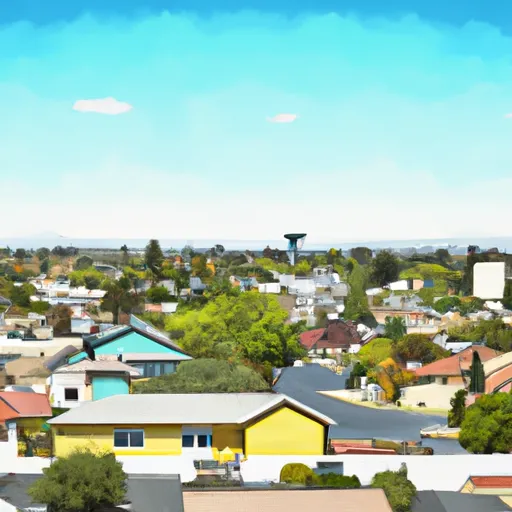-
 Snoflo Premium
Snoflo Premium
Get unlimited access to all our content
With no Ad interruptions! - Start Your Free Trial Login with existing account
Wilseyville
Eden Index
Climate
9.5
•
Recreation
4.6
•
Community
•
Safeguard
5.4/10

Wilseyville is a small unincorporated community located in Calaveras County, California. Situated in the Sierra Nevada foothills, the region boasts a Mediterranean climate characterized by hot, dry summers and mild, wet winters. Average high temperatures in summer range from the mid-80s to low 100s°F, while winter temperatures range from the mid-40s to low 60s°F. Precipitation mainly occurs between November and April, with an annual average of around 40 inches.
Hydrology constituents in Wilseyville primarily revolve around the Mokelumne River, which flows nearby. The river is fed by snowmelt from the Sierra Nevada Mountains and serves as a vital source of water for both residential and agricultural purposes in the region.
Outdoor recreation opportunities abound in Wilseyville and its surrounding areas. The region is a haven for nature enthusiasts, offering numerous opportunities for hiking, camping, and wildlife observation. Nearby attractions include the Calaveras Big Trees State Park, famous for its giant sequoia trees, and the Stanislaus National Forest, which offers various recreational activities such as fishing, boating, and skiing. Additionally, the Mokelumne River provides opportunities for fishing, kayaking, and rafting. With its diverse landscapes and natural beauty, Wilseyville is a great destination for outdoor lovers seeking to immerse themselves in the California wilderness.
What is the Eden Index?
The Snoflo Eden Index serves as a comprehensive rating system for regions, evaluating their desirability through a holistic assessment of climate health, outdoor recreation opportunities, and natural disaster risk, acknowledging the profound impact of these factors on livability and well-being.
Climate Health Indicator (CHI): 9.5
Wilseyville receives approximately
1257mm of rain per year,
with humidity levels near 75%
and air temperatures averaging around
14°C.
Wilseyville has a plant hardyness factor of
8, meaning
plants and agriculture in this region tend to thrive here all year round.
By considering the ideal temperature range, reliable water supplies, clean air, and stable seasonal rain or snowpacks, the Climate Health Indicator (CHI) underscores the significance of a healthy climate as the foundation for quality living.
A healthy climate is paramount for ensuring a high quality of life and livability in a region, fostering both physical well-being and environmental harmony. This can be characterized by ideal temperatures, reliable access to water supplies, clean air, and consistent seasonal rain or snowpacks.
Weather Forecast
Streamflow Conditions
San Joaquin
Area Rivers
San Joaquin
Snowpack Depths
San Joaquin
Reservoir Storage Capacity
San Joaquin
Groundwater Levels
Recreational Opportunity Index (ROI): 4.6
The Recreational Opportunity Index (ROI) recognizes the value of outdoor recreational options, such as parks, hiking trails, camping sites, and fishing spots, while acknowledging that climate plays a pivotal role in ensuring the comfort and consistency of these experiences.
Access to outdoor recreational opportunities, encompassing activities such as parks, hiking, camping, and fishing, is crucial for overall well-being, and the climate plays a pivotal role in enabling and enhancing these experiences, ensuring that individuals can engage in nature-based activities comfortably and consistently.
Camping Areas
| Campground | Campsites | Reservations | Toilets | Showers | Elevation |
|---|---|---|---|---|---|
| Rainbow - Sly Park Recreation Area | None | 3,579 ft | |||
| Deerwood - Sly Park Recreation Area | None | 3,622 ft | |||
| Capps Crossing | 11 | 5,122 ft | |||
| Pine Cone - Sly Park Recreation Area | None | 3,488 ft | |||
| Kane XXX - Sly Park Recreation Area | None | 3,588 ft | |||
| Pardoes Point | 10 | 5,845 ft | |||
| China Flat | 19 | 4,790 ft | |||
| Hazel Creek - Sly Park Recreation Area | None | 3,548 ft | |||
| Pipi | 51 | 3,922 ft | |||
| Sly Park | 191 | 3,596 ft |
Nearby Fishing
Nearby Ski Areas
Catastrophe Safeguard Index (CSI):
The Catastrophe Safeguard Index (CSI) recognizes that natural disaster risk, encompassing floods, fires, hurricanes, and tornadoes, can drastically affect safety and the overall appeal of an area.
The level of natural disaster risk in a region significantly affects safety and the overall livability, with climate change amplifying these risks by potentially increasing the frequency and intensity of events like floods, fires, hurricanes, and tornadoes, thereby posing substantial challenges to community resilience and well-being.
Community Resilience Indicator (CRI):
The Community Resilience Indicator (CRI) recognizes that education, healthcare, and socioeconomics are crucial to the well-being of a region. The CRI acknowledges the profound impact of these elements on residents' overall quality of life. By evaluating educational resources, healthcare accessibility, and economic inclusivity, the index captures the essential aspects that contribute to a thriving community, fostering resident satisfaction, equity, and social cohesion.

